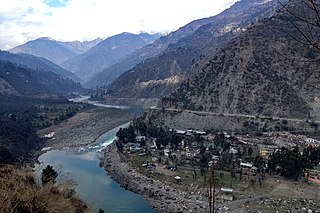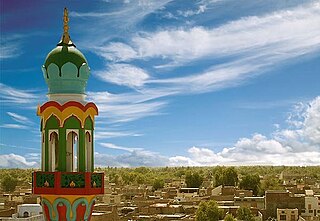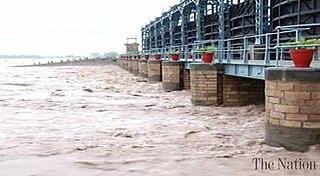
The Indus is a transboundary river of Asia and a trans-Himalayan river of South and Central Asia. The 3,120 km (1,940 mi) river rises in mountain springs northeast of Mount Kailash in Western Tibet, flows northwest through the disputed region of Kashmir, bends sharply to the left after the Nanga Parbat massif, and flows south-by-southwest through Pakistan, before emptying into the Arabian Sea near the port city of Karachi.

The Chenab River is a major river that flows in India and Pakistan, and is one of the 5 major rivers of the Punjab region. It is formed by the union of two headwaters, Chandra and Bhaga, which rise in the upper Himalayas in the Lahaul region of Himachal Pradesh, India. The Chenab flows through the Jammu region of Jammu and Kashmir, India into the plains of Punjab, Pakistan, before ultimately flowing into the Indus River.

Muzaffargarh is a city in the province of Punjab, Pakistan. Located on the bank of the Chenab River, it is the capital of the district with the same name. It is the 39th largest city of Pakistan by population.

Panjnad Headworks is located in Punjab, Pakistan. It is a beautiful picnic spot and an agricultural area near Uch, Bahawalpur and it is where all the five rivers of Punjab merge.

Sukkur Barrage is a barrage on the River Indus near the city of Sukkur in the Sindh province of Pakistan. The barrage was built during the British Raj from 1923 to 1932 and was named Lloyd Barrage. The Sukkur Barrage, is the pride of Pakistan's irrigation system as it is the largest single irrigation network of its kind in the world. It irrigates from Sukkur district in the north, to Mirpurkhas/Tharparkar and Hyderabad districts in the south of Sindh, almost all parts of the province. It is situated about 500 kilometres northeast of Karachi, 5 kilometres below the railway bridge, or the Sukkur Gorge. The introduction of barrage-controlled irrigation system resulted in more timely water supplies for the existing cultivated areas of Sindh province of Pakistan.

Layyah District, is a district in the Punjab, Pakistan. It is located in the southern part of the province. Layyah is the district headquarter of Layyah District. Layyah has hot desert climate.

Guddu Barrage is a barrage on the Indus River near Kashmore in the Sindh province of Pakistan. President Iskander Mirza laid the foundation-stone of Guddu Barrage on 2 February 1957. The barrage was completed in 1962 at a cost of 474.8 million rupees and inaugurated by Field Marshal Ayub Khan in 1962.

Rajanpur is a district of the Pakistani province of Punjab, with its administrative headquarters the city of Rajanpur. Lying west of the Indus River, its inhabitants are mostly Saraikis and Baloch. According to the 1998 census, the district had a population of 1,100,000, and 14.27% of these were inhabitants of urban areas.
Khanki Headworks is a headworks situated on the River Chenab in Gujranwala District of the Punjab province of Pakistan. The construction of this headworks was completed in 1889 and was one of the oldest headworks in Pakistan.

Marala Headworks is a headworks situated on the Chenab River near the city of Sialkot in Gujrat district in Punjab, Pakistan. A weir was first built during 1906–1912 in the British India to feed the Upper Chenab Canal, as part of the 'Triple Canals Project'. A new Marala Barrage was constructed in 1968 to feed the Marala–Ravi Link Canal in addition to the original Upper Chenab Canal.

The Islam Headworks, commonly known as Head Islam, is a headworks on the River Sutlej in Hasilpur Tehsil of the Punjab province of Pakistan. It is used for irrigation and flood control.
Makwal Kalan union council is in the Taunsa Tehsil subdivision of Dera Ghazi Khan District in the Punjab province of Pakistan, and is located at 30°35'06"N 70°43'55"E at an altitude of 135 metres (443 ft).
Shadan Lund is a small city in between Dera Ghazi Khan and Taunsa Shareef.Lund Is a Baloch tribe of Pakistan. Lund is Balochi word meaning "warrior".The Chief families are Haidrani Baloch.

Taunsa Sharif is a city in Punjab province of Pakistan. It is the capital of Taunsa District. Taunsa Sharif is primarily inhabited by Saraiki and Baloch descent people. It is situated on the bank of River Indus. Taunsa is an agricultural area known for its fertile land and crops.

Kot Addu is capital city of newly created Kot Addu District in the Punjab province of Pakistan. This city is subdivided into 5 Union Councils and has a population of over 104,000 making it the 70th largest city by population in Pakistan. It is located just east of the Indus River, about 100Km from Multan, 866 km (538 mi) from Karachi, 600 km (370 mi) from Islamabad , 80 km from D.G.Khan, 60 km (37 mi) from Muzaffargarh, 60 km from Layyah, and 16 km (9.9 mi) from Taunsa Barrage.
Rasul Barrage is a barrage on the River Jehlum between Jhelum District and Mandi Bahauddin District of the Punjab province of Pakistan. It is situated 72 km downstream of Mangla Dam.

The Punjab Irrigation Department is a provincial government department responsible for irrigation in the Punjab province of Pakistan. It irrigates 21 million acres (8,500,000 ha) of the agricultural land in the province.
Lashari wala Forest is forest located near Taunsa Barrage, a ramsar site in Punjab Pakistan. Taunsa ramsar site is among 19 ramsar sites in Pakistan. Taunsa Barrage was designated a ramsar site on 22 March 1996. The western brink of Head Taunsa Barrage stretches around 5,000-km in Kot Adu Muzaffargarh District of South Punjab, Pakistan, about 90 km from Multan and 10 km from Kot Adu.














